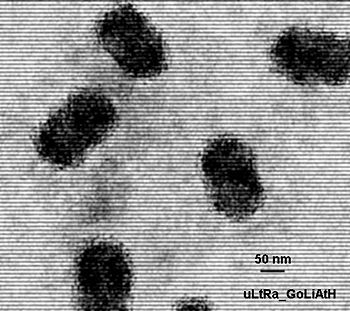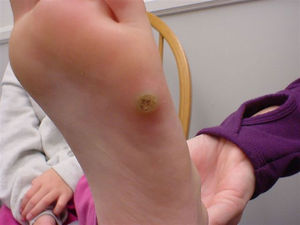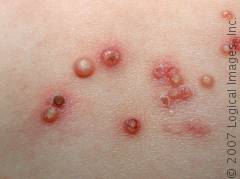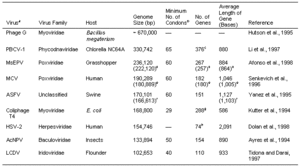Molluscum contagiosum
For the course duration, the article is closed to outside editing. Of course you can always leave comments on the discussion page. The anticipated date of course completion is May 21, 2009. One month after that date at the latest, this notice shall be removed. Besides, many other Citizendium articles welcome your collaboration! |
| Molluscum Contagiosum Virus | ||||||||
|---|---|---|---|---|---|---|---|---|
| [[image:|200px|]] | ||||||||
| Scientific classification | ||||||||
|
Introduction
Molluscum Contagiosum Virus was first described and later it was named by Bateman in the early nineteenth century.[1] Over time, there was more cases that were described and similar to this virus, and overtime there was more and more information gathered on this. Goodpasture later described the similarities of molluscum and vaccinia.[2] Molluscum Contagiosum Virus is a poxvirus, which is a member of the family Poxviridae. Poxvirus are viruses that can be a family that infect both vertebrate and invertebrate animals. Molluscum contagiosum is a viral infection that seems to cause lots of papules or nodules on the skin. This disease it thought to infect humans only, but there has been cases where they found animals with Molluscum Contagiosum. This virus is said to be most common in children, but is found in sexually active adults, and those that are not immuned. It is found worldwide with an increase in tropical areas. This disease is more prominent in areas, populations, institutions and communities with overcrowding, very bad hygiene, and high rate of poverty. They look like pimples with a pinkish, waxy, ugly look and a central pit, which can grow anywhere on an infected person.
Description and Significance
There are various types of Molluscum Contagiosum Virus, and they are most commonly seen on humans, but have been found to be on animals such as chickens, horses, oxes, cows, etc. On humans, they are seen on children and sexually active adults. This virus is very contagious that can spread by contact of infected individuals or by association with fomites. Fomites being infected clothes, toys, towels, etc.
It is found that there has been an increase of this disease mainly as a sexually transmitted disease, and seen that it is particularly rampant as a result of HIV (human immunodeficiency virus) infection. It is estimated to be between 5% to 20% of patients with HIV have symptoms of MCV. [5]
Taxonomy
To explain this further, Molluscum Contagiousum is a poxviruses from the family of Poxviridae. There are four genera, which are Orthopox, Parapox, Yatapox, and Molluscipox. Molluscipox gives rise to the virus Molluxcum Contagiosum. The name for Poxviridae viruses comes from the original grouping of the virus related with the disease that produced poxes on the skin. The subfamily is Chordopoxvirinae, with the Genus Molluscipoxvirus, and the species being MCV. Types of Viruses for each genera: Orthopox: variola virus, vaccinia virus, cowpox virus, monkeypox virus, smallpox ; Parapox: orf virus, pseudocowpox, bovine papular stomatitis virus; Yatapox: tanapox virus, yaba monkey tumor virus; Molluscipox: molluscum contagiosum virus (MCV).[6] There are four main subtypes of molluscum contagiosum: MCV I, MCV II, MCV III, and MCV IV. All subtypes cause similar clinical lesions in genital and nongenital regions. Studies show MCV I to be more prevalent (75%–90%) than MCV II, MCV III, and MCV IV, except in immunocompromised individuals.[7]
Genome Structure
[8]. By the colaboration of information from experiments conducted over the years by Tatiana G. Senkevicha, Eugene V. Kooninb, Joachim J. Bugertc, a, Gholamreza Daraic and Bernard Mossa, we discovered that the Molluscum Contagiosum Virus is a non-segmented molecule of double-stranded linear DNA with 180,000 to 200,000 nucleotides.It is said that there are 160 genes identified which encode 182 proteins. Among those, 105 proteins are counterparts in OPV (''Orthopoxviruses''). The OPV protein are considered to be the essential proteins for replication, and is noted that these proteins are highly conserved in MCV when undergoing transcription. There are twenty MCV proteins with OPV counterparts that have their own homologs, and some even have their own functional motifs. Despite other factors, the physical order and regulation of essential ancestral poxvirus genes have been largely conserved in these MCV's and OPV's. [9]The picture on the right is a table of Genomic information on various viruses.
They are usually complex struture and is consistent with the structure of poxviruses, with an envelope, core, surface membrane, and lateral bodies, and which contains infections in their envelope. The virons are in diameter of 200nm-300nm in length.[10]
Treatment
There are various ways to treat Molluscum Contagiosum.
Molluscum cantagiosum is a self-limited disease, which, left untreated, will eventually resolve in immunocompetent hosts but may be protracted in atopic and immunocompromised individuals. Some patients pick and scratch at the lesions, a habit that may lead to scarring. In addition, some schools and daycare centers will not admit children with visible molluscum papules. When patients seek medical attention and desire to rid themselves of the papules, there are several means of therapeutic destruction to help speed resolution. The decision whether treatment is necessary depends on the needs of the patient, the recalcitrance of their disease, and the likelihood of treatments to leave pigmentary alteration or scarring. Most of the common treatments consist of various means to traumatize the lesions. Antiviral and immune-modulating treatments have recently been added to the options. The following is a brief summary of some of the more common treatments.
Cryosurgery
One of the most common, quick, efficient methods of treatment is cryotherapy. Liquid nitrogen, dry ice, or Frigiderm are applied to each individual lesion for a few seconds. Repeat treatments in 2–3-week intervals may be required.[34] Hyper- or hypopigmentation and scarring may be caused by this treatment.
Evisceration
An easy method to remove the lesions is eviscerating the core with an instrument such as a scalpel, sharp tooth pick, edge of a glass slide, or any other instrument capable of removing the umbilicated core. Because of its simplicity, patients, parents, and caregivers may be taught this method so new lesions can be treated at home.[35,36] This method is simple but may not be tolerated by small children.
Curettage
Curettage is another method of removal. It can be used with and without light electrodessication. This method is more painful, and it is recommended that a topical anesthetic cream be applied to the lesions before the procedure to decrease the pain. This method has the advantage of providing a reliable tissue sample to confirm the diagnosis.[35,37]
Tape stripping
Another reported treatment involves the use of adhesive tape. The adhesive side of the tape is repeatedly applied to and removed from the lesion for 10–20 cycles. This action effectively removes the superficial epidermis from the top of the lesion.[38] However, repeated use of the same strip has the potential to spread the virus to adjacent, uninvolved skin.
Podophyllin and podofilox
A 25% suspension in a tincture of benzoin or alcohol may be applied once a week. This treatment requires some precautions. It contains two mutagens, quercetin and kaempherol. Some of the listed side effects include severe erosive damage in adjacent normal skin that may cause scarring and systemic effects such as peripheral neuropathy, renal damage, adynamic illeus, leucopenia, and thrombocytopenia, especially if used generously on mucosal surfaces. Podofilox is a safer alternative to podophyllin and may be used by the patient at home. The recommended use usually consists of application of 0.05 ml of 5% podofilox in lactate buffered ethanol twice a day for 3 days.[35,38] The active agent is absolutely contraindicated in pregnancy.
Cantharidin
Cantharidin (0.9% solution of collodian and acetone) has been used with success in the treatment of MCV. This blister-inducing agent is applied carefully and sparingly to the dome of the lesion with or without occlusion and left in place for at least 4 hours before being washed off. Cantharidin can cause severe blistering. It should be tested on individual lesions before treating large numbers of lesions. It should not be used on the face. When tolerated, this treatment is repeated every week until the lesions clear. Usually 1–3 treatments are necessary.[39]
Iodine solution and salicylic acid plaster
A 10% iodine solution is placed on the molluscum papules and, when dry, the site is covered with small pieces of 50% salicylic acid plaster and tape. The process is repeated daily after bathing. After the lesions have become erythematous in 3–7 days, only the iodine solution is applied. Resolution has been reported in a mean of 26 days.[40] Maceration and erosion can result.
Tretinoin
Tretinion 0.1% cream has been used in the treatment of MCV. It is applied twice daily to the lesions. Resolution was reported by day 11. Trace erythema at the site of prior lesions was a noted side effect.[41] Tretinion 0.05% cream has also been used with success and decreased irritation.[35]
Cimetdine
Oral cimetidine has successfully been used in extensive infections.[42] The histamine 2-receptor antagonist stimulates delayed-type hypersensivity. One uncontrolled study showed resolution in 9 of 13 patients. In this study, the dosage was 40 mg/kg/day in two divided doses for 2 months.[43] The authors recommended further placebo-controlled, double-blind studies be completed to determine the efficacy of cimetidine in treating MCV. Because cimetadine interacts with many systemic medications, a review of the patient's other medications is recommended.
Pulsed dye laser
The use of pulsed dye laser for the treatment of MC has also been documented with excellent results. The therapy was well tolerated, without scars or pigment anomalies. The lesions resolved without scarring at 2 weeks. Studies show 96%–99% of the lesions resolved with one treatment.[46,47] The pulsed dye laser is quick and efficient, but its expense makes it less cost effective than other options.
Imiquimod
Imiquimod 5% cream has been used topically to treat MCV by inducing high levels of IFN-α and other cytokines locally.[48,49] This potent immunomodulatory agent is well tolerated, although application site irritation is common. It has had no known systemic or toxic effects in children.[50] It is applied to the area nightly for 4 weeks. Clearing can take up to 3 months.
Prognosis
Reference
- ↑ Bateman F. Molluscum contagiosum. In: Shelley WB, Crissey JT, eds. Classics in Dermatology. Springfield IL; Charles C Thomas, 1953, p20.
- ↑ Bretz S. Molluscum Contagiosum. Emedicine Juournal April 25,2001;2(4).http://dermatology.cdlib.org/92/reviews/molluscum/diven.html#1
- ↑ |url:http://www.askdrsears.com/images/wartplantar.jpg
- ↑ |url:http://www.visualdxhealth.com/images/dx/webInfant/molluscumContagiosumPediatric_26550_med.jpg
- ↑ 1. Billstein SA. Mattaliano VJ Jr. The "nuisance" sexually transmitted diseases: Molluscum contagiosum, scabies, and crab lice. Med Clin North Am 1990; 74: 1487-1505. 2.Schwartz JJ. Myskowski PL: Molluscum contagiosum in patients with human immunodefificiency virus infection. J Am Acad Dermatol 1992;27:583. 3. Lombardo PC. Molluscum contagiosum and the acquired immunodeficiency syndrome. Arch Dermatol 1985; 121: 834-835.http://dermatology.cdlib.org/92/reviews/molluscum/diven.html#1
- ↑ http://en.wikipedia.org/wiki/Poxviridae
- ↑ Gottlieb SL, Myskowki PL. Molluscum contagiosum. Int J Dermatol 33: 453-461,1994. Yamashita H, Uemura T, Kawashima M. Molecular epidemiologic analysis of Japanese patients with molluscum contagiosum. Int J Dermatol 1996;35:99-105.
- ↑ Etten, James L. Van (2002) http://www7.nationalacademies.org/ssb/nanopanel2vanetten-1.gif
- ↑ Tatiana G. Senkevicha, Eugene V. Kooninb, Joachim J. Bugertc.Received 18 February 1997; revised 26 March 1997; accepted 15 April 1997. ; Available online 12 April 2002. http://www.sciencedirect.com/science?_ob=ArticleURL&_udi=B6WXR-45K15Y8-6D&_user=10&_rdoc=1&_fmt=&_orig=search&_sort=d&view=c&_acct=C000050221&_version=1&_urlVersion=0&_userid=10&md5=54d0c349fe732cbe9bf360a3a8090d03#bm4.1
- ↑ http://en.wikipedia.org/wiki/Poxviridae



